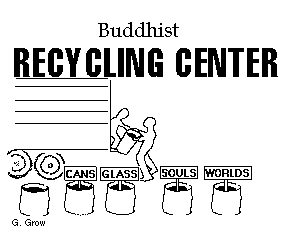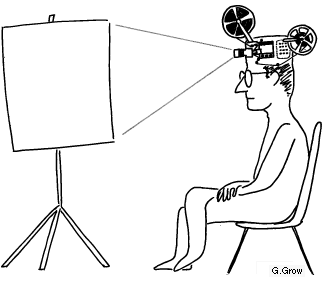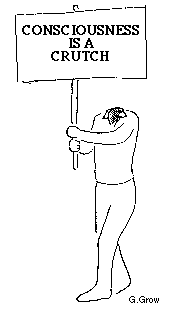If it leads to compassion, you know it's knowledge. Otherwise, it's just more information.
by Gerald Grow
Copyright © 1996. Revision of March 13, 2008. All rights reserved. An original WWW publication.
Available at http://www.longleaf.net/ggrow

European history was deeply changed when Protestantism arose in 1517 in rebellion against the Catholicism of its day. In a similar way, Buddhism arose on the northern border of India around 500 B.C. in response to the Vedantic Hinduism of its day. Like medieval Catholicism, ancient Hinduism was a religion of rituals, with an elite priesthood who administered a complex theology. It supported a society in which people were rigidly divided into a system of caste, role, and power.
Like Martin Luther, Buddha proposed radical alternatives to the religion of his day--some of which resemble the ideas of the Protestant reformation. Buddha advocated individual effort, plain language and simple means. His approach emphasized direct experience rather than relying on priests or theology. In his vision, all people (including women and the poor) were equal and equally capable of spiritual development.
Although some sects later considered him divine, Buddha spoke of himself only as "one who is awake." Original Buddhism was less like a religion than like a set of psychological practices--exercises to do with your mind until you no longer need them--a raft to be discarded after you have crossed the stream.
The core of Buddhism spread to India, China, Korea, Japan, Southeast Asia, and Tibet--where it combined with the native traditions of each place to produce results as different as Zen --with its Japanese starkness and piercing beauty--and the colorful cheerfulness of Tibetan monks. Thailand and Burma claim to be the most direct descendants of Buddha's vision, though, naturally, others claim to be the true religion as well.
Buddhism seems to have arrived in America sometime in the 19th Century. Emerson and Thoreau were touched by it. According to Peter Matthiessen, the first Zen master known in America arrived in the 1890s, and shortly afterward, D. T. Suzuki began a long career of translating texts and writing about Buddhism, influencing such influential thinkers as Jung, Heidigger, and Toynbee in Europe and, in America, Aldous Huxley and Eric Fromm. Zen attracted the interest of several prominent American artists of the Beat Generation, including Allen Ginsberg and John Cage. Buddhism arrived in this country a second time after a wave of Tibetan lamas (driven out by the Chinese invasion of 1950) arrived in America the 1970s, established centers like the Naropa and Nyingma Institutes, set up schools and publishing houses, and began teaching on a wide scale.
Buddhism has attracted a large following among American intellectuals, perhaps because Buddhism contains so much insight on how to use the mind to tame the mind's excesses. Though many seem to have been puzzled by Bertolucci's 1994 film, "Little Buddha" (with its sudden shifts among realism, fable, and Indian operatic styles), it spoke to a growing interest in this country in the spiritual teachings of other cultures.
The Message of the Buddha
Buddha described his message in simple terms (the Four Noble Truths) that are somewhat difficult to discuss, because they do not refer to ideas so much as to experience.
1. Life is Suffering
To live is to suffer. Life is accompanied by inevitable pain, sickness, disappointment, disillusion, decay and death. This place we live on, the earth plane, is characterized by inevitable and unavoidable dissatisfaction, disappointment, rejection, failure, pain, yearning, decrepitude, and loss. "Suffering" in Buddhism refers not only to physical pain, aging, sickness, and death, and to emotional pain like fear, loss, jealousy, disappointment, and unrequited love, but also to the existential sense that, somehow, deep down, life is permanently out of joint. Everything is touched by the shadow of dissatisfaction, imperfection, disappointment. Suffering, in the Buddhist sense, is a pervasive condition. No one escapes it. Even enlightened teachers grow old, suffer the pains of decay, and die.
2. Suffering is Caused by Attachment
Suffering arises because everything changes, everything is impermanent. Everything is in process, all the time. Whenever we hope to find any lasting happiness by means of something that is changing, suffering results. This means that nothing in the realm of ordinary human experience can provide lasting happiness, and trying to force things to stand still and make us happy is itself the main source of misery.
"Attachment" in Buddhism extends far beyond the sense of "greed" or "clinging" to something closer to what the Christian tradition would call "pride"--a self-centered isolation, the separate selfhood, "ego" in the worst sense.
This selfhood acts upon others and the world as if they were forever separate from oneself, generating what author Charlene Spretnak described as "the continuous chain reaction of craving, jealousy, ill will, indifference, fear, and anxiety that fills the mind." This is a deep, pervasive, but normal kind of alienation--one seemingly built into the nature of the human nervous system.
 |
| In Buddhism, three concepts are said to characterize all things: - Anicca -- Nothing is permanent. Everything changes.
- Anatta (or anatman) -- There is no separate self. What appears separate and enduring turns out to be changeable and "composite." What we experience as identity turns out to be a changing constellation of varying influences.
- Dukkha -- to believe otherwise, to cling to any thing or anyone (including yourself), expecting it to be enduring, whole, and a self, is to create and amplify suffering. And we all do it -- at least until we become, we hope, enlightened.
Naturally, these concepts have been interpreted in many ways by many thoughtful people, including the Mayahana interpretation that our ordinary self is a non-self, but that we have a deep, true Buddha-nature that can be awakened. |
The most pervasive form of self-centered suffering takes place as we project upon everyday experience a huge burden of extraneous interpretations, associations, fantasies, emotions, painful memories, and diversions. We act then with the Buddhist big three problems: greed, aversion, and delusion. Greed sucks things in to our purposes, violating their natures as necessary. Aversion shoves things away, denies, distorts, destroys them--again violating their natures. In the state of delusion, we float, confused, not seeing, not knowing, insulated from the pain and salvation of deep experience.
Instead of seeing each moment as it is, we react to each moment from our past pain and frustration; then we react to the pain and frustration; then we react to that reaction; and so on and on. In this way a special form of mental torment is created that consists of seemingly endless layers of pain, negative emotion, self-doubt and self-justification--known in Buddhism as "samsara," the illusory world we think of as real. It is what, in honest moments, many people might call "normality."
I think of it this way: Instead of experiencing life directly, we create a worldview and experience it. That worldview serves to protect us through a system of explanations; but it also makes each of us into an isolated self, separated from nature, from real experience, from spirituality, and from one another--causing all experience to be distorted and "out of joint," and ourselves to suffer from living at one remove from life. We are nearly always, in some degree, outsiders to the world and even to our own experience.

Buddhists have given deep attention to the ways human beings are at once empowered and entrapped by the categories we create for thought and language. Racial prejudice is a straightforward example of what Buddhists mean by suffering that is created by the mind; it is based on mental categories that distort perception and project our expectations onto others. The fundamental Buddhist act is to accept responsibility for one's projections, and to learn to know, first hand, how the mind creates illusion and amplifies suffering.
3. Freedom from Attachment is the Cure for Suffering
If we could be released from attachment, we would be released from suffering. And our primary attachment is to the concept of a separate, isolated self--from which we derive all other attachments and experience all other sufferings.
This I understand to be the central belief of Buddhism: When we fully face, accept, and lighten the self-amplified sufferings of our lives; when we begin to experience life beyond our delusions and confusions, beyond self, beyond culture, beyond knowledge--what we find is not a meaningless universe of alien forces, but our true home.
Life is real. Reality is good. Goodness, gratitude, love and joy are the natural state of the awakened heart.
When people begin to feel released from their self-sustained sufferings, they experience life more fully, they become more cheerful and compassionate. Most people have heard of the ultimate release--"nirvana"--a state of mystical unity with the cosmos. Fewer people know the moving story of how the Buddha and his major followers throughout history have approached nirvana, only to turn back from that mystical escape and devote themselves to a life of helping others in this imperfect world.
Enlightened people do not cease to experience the pain of existence. They only stop creating illusions that amplify that pain and cause new suffering. The rest of us, far from being enlightened, might try to stop making things worse than they are, to stop creating unnecessary suffering, and, by accepting life as it is, accept also the depth and vibrancy of experience.
4. The Way Out of Suffering is through the Eightfold Path
Buddha taught a method to lead away from self-sustained suffering toward a more enlightened and compassionate life--through the pursuit of morality, meditation, and wisdom, described as eight pursuits: right speech, right action, right livelihood, right concentration, right mindfulness, right effort, right understanding and right thought.
Because it avoids the extremes of asceticism and indulgence in favor of a life of moderation, nonviolence and compassion, Buddhism is known as the "Middle Way."
In the West, we tend to expect theological concepts to come in the form of logical propositions -- something that traces back at least as far as Aquinas' adaptation of Aristotle. Buddhism has a philosophical literature, to be sure, but most of the Buddhist writings encountered by lay persons seem not to be theo-logical as much as they are concepts that inspire and guide practice.
In this sense, Buddhism bears a resemblance to hatha yoga, Taoism, or tai chi. These are not systems of thought as much as they are systems of action -- practices. Theology, belief, and faith are surely intended to change the mind and heart. Practices such as the Buddhist practice of meditation and the other aspects of the eight-fold path, are another method to change the mind and heart, a method that -- as I understand it -- depends less on what you believe about God than on what you do each day.
Some Buddhist teachers emphasize the use of "skillful means," something kin to the Jesuit's willingness to adapt Catholic rituals to accommodate local customs. In skillful means, you take on a set of practices and concepts -- not because they stand for eternal truths, but because they get you somewhere. And, once you get there, once you cross the stream, you no longer need to carry the raft on your shoulders. In the words of St. Paul, you put away childish things. Indeed, perhaps all beliefs, all ideas, all concepts are but skillful means.
Buddhist Meditation
Meditation is but one part of the Buddhist path, but it is a part that is accessible to anyone, anywhere. Though Buddhist meditation cannot be learned in any depth without a teacher, the basic practice is simple. In meditation, Buddhists do not remove themselves from the world as some other schools of meditation do; rather, Buddhists practice a kind of awareness that enables them to be more fully present in the world.
Original Buddhist practices (known today as "vipassana" or "insight meditation") are sometimes austere. They may require years of daily sitting in silent meditation. In several cultures, such as Tibet, Buddhism developed into a multifaceted religion ("Mahayana" and "Vajrayana" Buddhism) which adds singing, movement, temples, ceremony, priests, scriptures, art, and other "religious" activities, so that it appeals to a greater variety of people. Still, vipassana meditation remains the underlying mental technology upon which Buddhism rests.
In a characteristic Buddhist meditation, you sit quietly and, in a non-directive way, allow attention to gently settle upon the ever-changing process of your breathing. When you become aware that your attention has shifted to something else, notice this fact, label that moment simply as "thinking," and guide your attention back to the breathing.
Why would anyone do this? Over time, this kind of mental inventory has the effect of changing the relationship you have with your thoughts and feelings. Little by little, you stop blindly reacting to them and begin to develop a space in which to choose how to respond, how to act, what to intend. You start to unhook the automatic cycle of reactivity and gain some freedom, as if your thoughts were only clouds floating across an immensely large, deep sky. It is important, however, not to blame yourself for having reactive thoughts and feelings. Those seem to be a natural part of being human. It is also natural to apply yourself in a disciplined way to learn to live less reactively.
Another instruction attributed to the Buddha directs you toward feeling love, kindness, and compassion progressively for yourself, those close to you, other people, those who have wronged you, and ultimately for all beings.
To the Western mind, it seems absurd that millions of people, sitting in silence, can change the world, end wars, improve humanity, feed the poor, care for the sick, etc. But it not so different from the Christian belief that prayer prepares one to be more loving and more just.

Meditation is an attempt to address the most fundamental causes of human misery. The Buddhist attempt to end war begins with cultivating inner peace, developing an unwavering ability to see things as they are, and treating all beings with compassion and respect.
The Buddhist View of the World
A few Buddhists concepts seem strange to the modern mind. Buddha inherited the Indian belief in reincarnation: Each person has lived before, and past lives influence how you experience this one.
More strange, Buddha said that, although people reincarnate, they have no souls. In part, this seems to be a reaction to the ancient Hindu belief in an immutable, eternal soul (atman) that migrates through many lifetimes.
In part, though, Buddha arrived at this conclusion by his radical method of awareness. Buddhism invites you to look unwaveringly at every experience and ask, "Is it solid, unchanging, whole?"
The answer, Buddhists say, is always, "No"--even when asked of the soul. Everything changes. Everything is impermanent. It is our attempt to attach ourselves to impermanent things, and gain happiness thereby, that guarantees and perpetuates suffering.
In some important ways, the Buddhist view of the universe resembles the view developed by 20th-century physics. Except for the mental categories we impose upon experience, we find nothing in experience that is immutable. There is no constant but our own misconceptions and our own doomed instinct to deny change. Every "thing" is actually a process--it arises, develops, flourishes, declines, and dissipates. All nouns are still-photos from the movie of life--which is made up of verbs. All that we see around and inside us is the result of trillions of simultaneous processes, arising and declining in a symphony of different overlapping rhythms at once. All that appears solid in this cosmos is in reality a shimmering, substanceless dance of energy in flux.
This shimmering immensity of inexhaustible becoming, out of which all things arise and to which they return, is lightly labled by such terms as emptiness, the void, the one reality, and Buddha-mind.
But where the shimmering reality of physics leaves us adrift like meaningless specks in an incomprehensible universe, Buddhism envisions a reality beyond meaning and meaninglessness, beyond knowing, beyond self, beyond duality, beyond suffering--a dance of all things, in which we can become enlightened, interconnected, and compassionate dancers.
The crucial distinction, I believe, is this: Many people have looked deeply into the human condition and come back cynical, ironic, bitter, or insane. Buddhists would say that such people did not look deeply enough into suffering to detect their own contribution to it, and hence the direction out.
Buddhists teach this: True insight leads to compassion. Insight is compassion. Seeing your own condition, your own imperfections, your own joys and thoughts, pains and disappointments, illusions and delights, shows you, not "your" separate and individual mind, but "mind" itself--the universal shared experience of all people.
Pain is not just "your" separate and individual pain. It is "the" pain that others, everywhere, feel.
Joy is not "your" separate and individual joy. It is "the" joy that others, everywhere, feel.
When you dig deep enough, all the wells run together in a place where every wave celebrates that it is the ocean moving through form after form.
People ask, "Is there a God?" "Do we live after death?" "Does life have meaning?"--To all such questions, the Buddha replied with directions to attend to the immediate problems caused by the way we use our minds to distort life and amplify suffering. He taught that we must first remove the poisoned arrow from our consciousness. Afterwards, we can have intricate discussions about where the arrow was shot from, who made it, what wood it is made from, how the point was sharpened, what kind of bow was used, and whether there is a God or an afterlife.
Meanwhile, act now to counteract the habits that poison the mind. Act now to remember the clarity, compassion, and joyfulness of your true nature. Nothing else is as urgent. And this human life, right now, is a rare, precious opportunity to choose to return to the roots of your being, avoid reactivity, and promote clarity, kindness, and compassion.
According to Buddhism as I understand it (and I am not a Buddhist, only a grateful student of human spirituality) the dance of process, continuous change, and boundless creative vitality is what is ultimately real; and we are born with the potential for knowing it directly -- and most directly in the most ordinary moments of our daily lives. As some Zen practitioners put it, everything is interconnected; therefore, if one thing is real, everything is real. So attend wholly to the one thing before you, and it will make all the rest of the universe stop reeling and become real again. And the radiance of the entire universe will dwell in that one small thing.
Where Christianity envisions Heaven and Hell, Buddhism directs our attention to the several tastes in the tea, to how the changing light shines through each particular leaf, to the way this person is speaking to us now -- and to the eternal moment inside ordinary things.
No matter what our abstracting mind and categorical language tell us, there is no dance separate from the dancers. The dancers and the dance are one. And one with us.
For further reading
The one book I most recommend to start with is: Buddhism, A Way of Life and Thought, by Nancy Wilson Ross. Vintage Press.
Peter Matthiessen, Nine-Headed Dragon River (Boston, Shambhala, 1987) (A moving, poetic account of Matthiessen's spiritual experiences as a student of Zen.)
Huston Smith, The World's Religions (San Francisco: HarperCollins, 1991).
Charlene Spretnak, States of Grace: The Recovery of Meaning in the Postmodern Age (San Francisco: HarperCollins, 1991). (Her Buddhist critique of deconstruction is well worth looking at.)
Joseph Goldstein and Jack Kornfield, Seeking the Heart of Wisdom: The Path of Insight Meditation (Boston: Shambhala, 1987).
Sogyal Rinpoche, The Tibetan Book of Living and Dying. HarperSanFrancisco, 1993.
Chogyam Trungpa, Shambhala: The Sacred Path of the Warrior (Boston: Shambhala, 1984).
For a more technical, scholarly account, see Rahula, Walpola, What the Buddha Taught
Gerald Grow's mind-clearing exercise, a Westernized version of a basic Buddhist meditation.
Gerald Grow's photo essay, "Dissolution of the Mandala.
Gerald Grow's essay, "Touching the Face of the Buddha."
"We are literally made from stars." -- a brief inspirational essay on interconnectedness.




